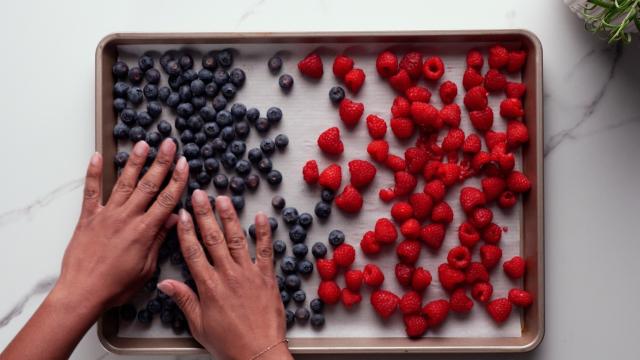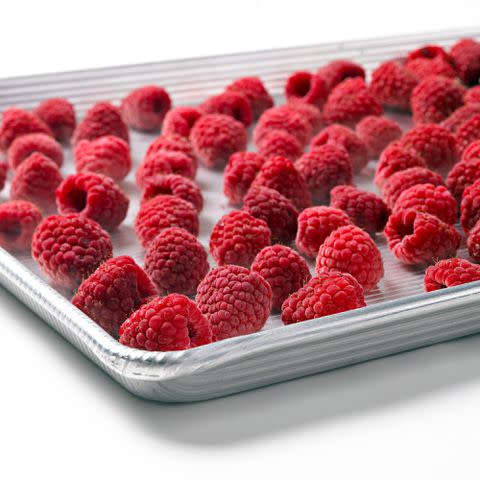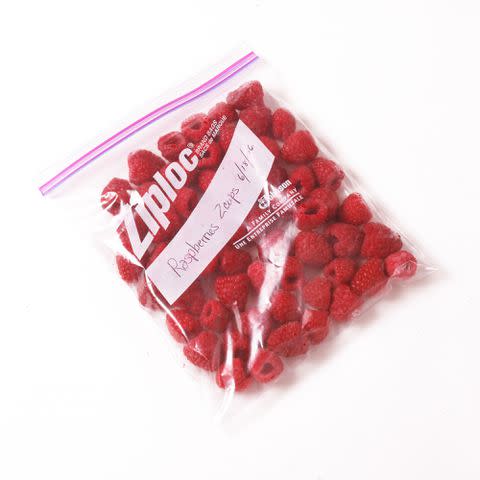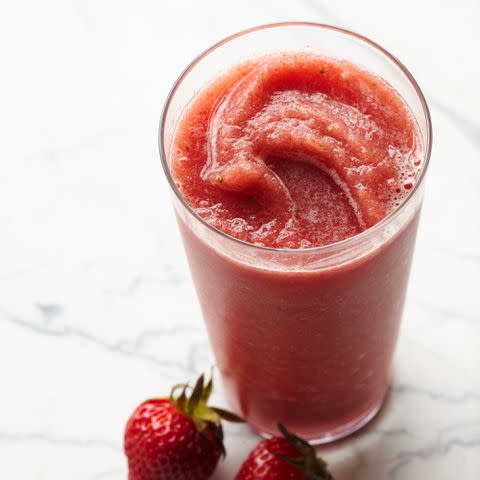How to Flash Freeze Food for Easy Grab-and-Go Portions

Your next meal, snack, or single-serving dessert is just a quick thaw away.
Sometimes, you need just a handful of this or a little bit of that: strawberries for a smoothie, a single hot dog to satisfy a hungry child, or a quick lunch to take to work. If you flash freeze small portions of food, that handful of berries or last-minute meal can be ready and waiting in the freezer.
So, what does flash freeze mean? In the food industry—or on fast-paced TV cooking shows—this term means freezing foods at extremely low temperatures with circulating air. (It's also sometimes called "blast freezing.") This quick-chill method keeps ice crystals small, which prevents moisture loss in the food when it thaws.
For the home cook, however, the definition of flash freeze is different: Flash freezing refers to freezing individual pieces of food, usually spread out on a baking sheet, then packing them in airtight containers for longer storage. This method allows you to thaw and use just the amount of food rather than pulling out more than you need from your freezer.
Related: The 10 Best Food Storage Containers for Keeping Your Lunches and Leftovers Fresh
How to Flash Freeze Foods
You'll need a baking sheet or tray that fits in your freezer and freezer-safe containers or resealable bags to get started. Depending on what you're freezing, you may need plastic freezer wrap or heavy-duty aluminum foil.

1. Prepare Food for Flash Freezing
Most foods don't need to be washed before you flash freeze them. However, you should always rinse berries (or any fresh produce) and pat them dry.
If applicable, divide food into small, individual portions or pieces. This step makes sense for preportioned or easily divided foods, such as dinner rolls, chicken breasts, meatballs, and cooked meat loaf.
Place the food on a baking sheet or tray. Make sure the edges of the pieces don't touch, as this can cause them to fuse together while they chill. Freeze for 2 to 3 hours or until firm.
Test Kitchen Tip
Line the baking sheet or tray with parchment paper, waxed paper, or plastic wrap before adding the food for easier cleanup.

2. Seal or Wrap, Label, and Freeze
After you flash freeze, remove the food from the baking sheet and wrap it in either plastic freezer wrap or heavy-duty aluminum foil. Alternatively, transfer it to resealable freezer bags or freezer-safe food-storage containers with tight-fitting lids.
Label the package using a wax crayon or permanent marker, indicating the name of the item, the quantity or size, and the date it was frozen.
Return the food to the freezer.
Test Kitchen Tip
Do not use foil to wrap foods that contain acidic ingredients, such as tomatoes or lemon juice, since acid reacts with aluminum foil. Instead, use plastic freezer wrap.
Foods You Can Flash Freeze
Whether raw or cooked, you can flash freeze just about any food that comes in individual pieces (or can be broken/cut into individual pieces). The best candidates, however, are those foods that freeze well in general and are particularly useful in smaller portions. Here are some examples:
Fresh berries, such as blueberries, raspberries, and strawberries
Individual portions of meats, such as chicken breast halves, steaks, and hot dogs
Cooked or uncooked hamburger patties, meatballs, and bacon slices
Fish steaks or fillets, shrimp, and scallops
Baked cookies, scones, and muffins
Baked bread slices, rolls, and biscuits
Unbaked bread dough shaped into rolls
Shaped unbaked cookie dough
Individual slices of cake, fruit pie, or cheesecake
Related: Freeze Fruit Pies Now to Enjoy Months in the Future
Foods That You Shouldn't Flash Freeze
Because they lose flavor, texture, and/or overall quality when frozen, you shouldn't flash-freeze these foods:
Eggs in shells, whether raw or cooked
Cooked egg whites or yolks
Custard- or cream-based pies or other desserts with cream fillings
Cheese
Battered and fried foods
Stuffed chops or chicken breasts
Fresh fruits and vegetables: Most fresh fruits except berries) and vegetables are not suitable for flash freezing. They may be frozen but require specific steps beforehand, such as blanching or packing in water, fruit juice, or syrup.
Soups, stews, and other soft or liquid dishes. (These are freezable but are not an option to flash freeze since they can't stand on their own on a baking sheet.)
Related: How to Freeze Soup in Bags or Containers for Make-Ahead Meals

How Long to Freeze Flash-Frozen Food
According to the USDA, food stored at temperatures of 0°F or below will always be safe to eat. That's because freezing prevents the growth of the microorganisms that cause foodborne illness. However, frozen foods might lose flavor, texture, or quality over time. We recommend sticking within these times when you flash-freeze food:
Cooked Items
Baked cookies, slices of cake, fruit pies, quick breads, and yeast breads: 3 months
Individual slices of cheesecake: 2 weeks
Cooked meats, such as pork chops, chicken breasts, and meatloaf slices: 3 months
Raw Items
Berries: 1 year
Uncooked ground meat patties: 3 months
Uncooked fish and shellfish: 3 months
Uncooked steaks, chops, and poultry pieces: 3 to 6 months
Unbaked bread and cookie dough: 3 months
When ready to prepare or consume, thaw frozen foods in the refrigerator or microwave, never at room temperature (exceptions include breads and sweets that can safely be stored at room temperature). Inspired to go a step further? Make freezer-friendly family meals that are great for weeknight eating, and you'll have dinner in a flash on busy evenings.
What Foods Can You Freeze?
You may not be able to flash-freeze eggs, but they can be frozen if you take them out of the shell. Hummus is also freezable, but you must do it correctly to preserve the flavor and texture. Instead of tossing almost-too-ripe bananas, freeze them to use in the future. Be prepared for rushed mornings by freezing pancakes for a quick breakfast.
Once you've decided to start freezing foods to keep from wasting them, whether you flash freeze or add them to the freezer already packaged, make sure you keep your freezer organized and everything clearly labeled so you'll know what's inside the bag or container you pull out a few months from now.
For more Better Homes & Gardens news, make sure to sign up for our newsletter!
Read the original article on Better Homes & Gardens.